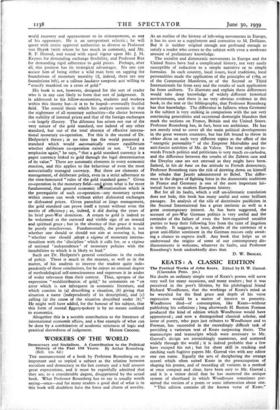KEATS : A CLASSIC EDITION
No doubt an ordinary simple text of Keats's poems will serve very well for many occasions, and many readers ; but it was perceived in the poet's lifetime, by his philological friend Richard Woodhouse, that the workings of Keats's mind as he wrestled for the final grace and depth of his verse expression would be a matter of interest to posterity. Woodhouse died—of consumption, like Keats—without publishing his collations ; Iong afterwards H. Buxton Forman produced the kind of edition which Woodhouse would have appreciated ; and now a distinguished classical scholar, and lover of poetry, who pays just tributes to Woodhouse and to Forman, has succeeded in the exceedingly difficult task of providing a variorum text of Keats surpassing theirs. The manuscripts and transcripts which were necessary to Mr. Garrod's design are astonishingly numerous, and scattered widely through the world ; it is indeed probable that a few have escaped his net ; but for sheer skill in tracking and catching such fugitive papers Mr. Garrod vies with any editor one can name. Equally the arts of deciphering the strange scrawl which often suited Keats in the preoccupation of shaping his poems, and of recording all variants in a method at once compact and clear, have been easy to Mr. Garrod ; and it is a minor detail that he has mastered the antique system of shorthand in which Woodhouse sometimes pre- served the version of a poem or some information about one.
" This edition contains all the known verse of Keats." Even Mr. Garrod could not glean unpublished pieces of great number or value, though he gives several pleasant trifles illustrating the social charm of their author ; and we must conclude, almost without any reserve, that no new poem by Keats is now waiting to be disclosed. Perhaps some boyish compositions, the work of days before Woodhouse fastened on his man of genius, remain somewhere ; and the editor notices two or three late' pieces which are mentioned by Keats's friends but otherwise are unknown. The strength of the new edition lies in the profuse alternative readings and rejected passages, so many of them hitherto concealed. With one so ardent in quest of the complete word as Keats, there is always a possibility of poetic value even in the colour and sound and symbol which were presently superseded. In only one poem can be observed an important deficiency of such " brave transitory things," and that through no fault of Mr. Garrod : there was a passage in the middle of " The Eve of St. Agnes" which, by its freedom, disturbed the modesty of Woodhouse and Keats's publishers, and may have gone for ever.
In some preliminary papers Mr. Garrod discourses with delightful ease and wit upon the problems of editorship, and curious matters relating to Keats and his poems and manu- scripts. Incidentally he suggests, with much to support the suggestion, that Keats's usually accepted date of birth, October 31st, 1795, is wrong, and that June, 1795, might be nearer ; he also works out the probable date of Keats's first meeting with Leigh Hunt, and makes it October gth (or soon after), 1816. These are only instances of the passion and gift for solving the countless minor problems offered by the life and writings of Keats which must make this edition a hunting-ground for many enthusiasts. Some things here are especially pleasing to the fancy : what, for example, was in Keats's mind when he wrote " Stitch creeds together for a sail " (for Melancholy) ? Mr. Garrod has traced the once baffling verb " finagle " ; a synonym perhaps for " wangle," it left England long ago for the United States, and has lately appeared in the works of Damon Runyon. There is still no manuscript clue to the punctuation (and therefore the significance) of the last two lines of the " Grecian Urn," which in fact is one of the very few prominent poems by Keats not known to exist in his autograph.
EDMUND BLUNDEN.











































 Previous page
Previous page